Abstract
Purpose
It is a common practice to increase the gonadotropin dose during ovarian stimulation when the estradiol (E2) rise is found to be inadequate. The prognostic impact of the use of this step-up regimen on the outcome of the affected in vitro fertilization (IVF) cycle is the subject of this study.
Methods
This is a retrospective analysis of IVF cycles in a series of consecutive patients who required an increase in the gonadotropin dosage during the stimulation phase because of inadequate E2 rise. Controls consisted of patients in whom the dose was not increased. After 4 days of stimulation, the gonadotropin dosage was increased if E2 levels failed to rise by 70% every 2 days. Outcome was defined in terms of maximum E2 level, number of follicles at aspiration, number of oocytes obtained, fertility rate, and pregnancy rate and was compared in study and control patients. Pregnancy was defined by sonographic demonstration of cardiovascular activity.
Results
One hundred forty-five patients were analyzed. A stepup regimen was used in 35 patients (24.1%). Patients who required the step-up dosing had significantly lower peak E2 levels (1373 vs 1828 pg/ml; P < 0.005), fewer follicles measuring greater than 16 mm (7.2 vs 9.7; P < 0.003), and fewer oocytes recovered (8.3 vs 11.2; P < 0.009). The fertilization rate (67.6 vs 64.2%) was not significantly different. The pregnancy rate (8.5 vs 32.7%; P < 0.004) was significantly lower in the group requiring the stepup regimen.
Conclusions
The utilization of a step-up regimen during an IVF treatment cycle is a predictor of a poor outcome for the specific IVF cycle. As this information is available before retrieval, consideration of cycle cancellation may be appropriate.
Similar content being viewed by others
References
van Hooff MHA, Alberda AT, Huisman GJ, Zeilmaker GH, Leerentveld RA: Doubling the human menopausal gonadotrophin dose in the course of an in-vitro fertilization treatment cycle in low responders: A randomized study. Hum Reprod 1993:8:369–373
Stadtmauer L, Ditkoff EC, Session D, Kelly A: High dosages of gonadotropins are associated with poor pregnancy outcomes after in vitro fertilization-embryo transfer. Fertil Steril 1994:61:1058–1064
Durrelman S, Simon R: Flexible regression models with cubic splines. Stat Med 1989:8:551–561
Beauchamp PJ: Human menopausal gonadotropin for follicular recruitment in in vitro fertilization and embryo transfer.In Human In Vitro Fertilization and Embryo Transfer, DP Wolf, MM Quigley (eds). New York, Plenum Press, 1984, p 99
Sato F, Marrs RP: Effect of ovarian hyperstimulation on chromosome aberration and sister chromatid exchange on in vivo fertilized oocytes. Fertil Steril 1984:41:245–247
Simon T, Oehninger S, Toner J, Jones D, Muasher S: High doses of gonadotropins have no detrimental effect on in vitro fertilization outcome in normal responders. Fertil Steril 1995:63:1333–1336
Manzi DL, Thorton KL, Scott LB, Nulsen JC: The value of increasing the dose of human menopausal gonadotropins in women who initially demonstrate a poor response. Fertil Steril 1994;62:251–256
Land JA, Yarmolinskaya MI, Dumoulin JCM, Evers JLH: Highdose human menopausal gonadotropin stimulation in poor responders does not improve IVF outcome. Fertil Steril 1996;65:961–965
Padilla SL, Dugan K, Maruschak V, Shalika S, Smith RD: Use of the flare-up protocol with high dose human follicle stimulation hormone and human menopausal gonadotropins for in vitro fertilization in poor responders. Fertil Steril 1996, 65:796–799
Antoine JM: Which stimulation for poor responders? Critical study of results and methods of research. Contracept Fertil Sex 1996;24:386–390
Lindheim SR, Barad DH, Witt B, Ditkoff E, Sauer MV: Shortterm gonadotropin suppression with oral contraceptives benefits poor responders prior to controlled ovarian hyperstimulation. J Assist Roprod Genet 1996; 13:745–747
Author information
Authors and Affiliations
Rights and permissions
About this article
Cite this article
Hock, D.L., Louie, H., Shelden, R.M. et al. The need to step up the gonadotropin dosage in the stimulation phase of IVF treatment predicts a poor outcome. J Assist Reprod Genet 15, 427–430 (1998). https://doi.org/10.1007/BF02744936
Received:
Accepted:
Issue Date:
DOI: https://doi.org/10.1007/BF02744936



